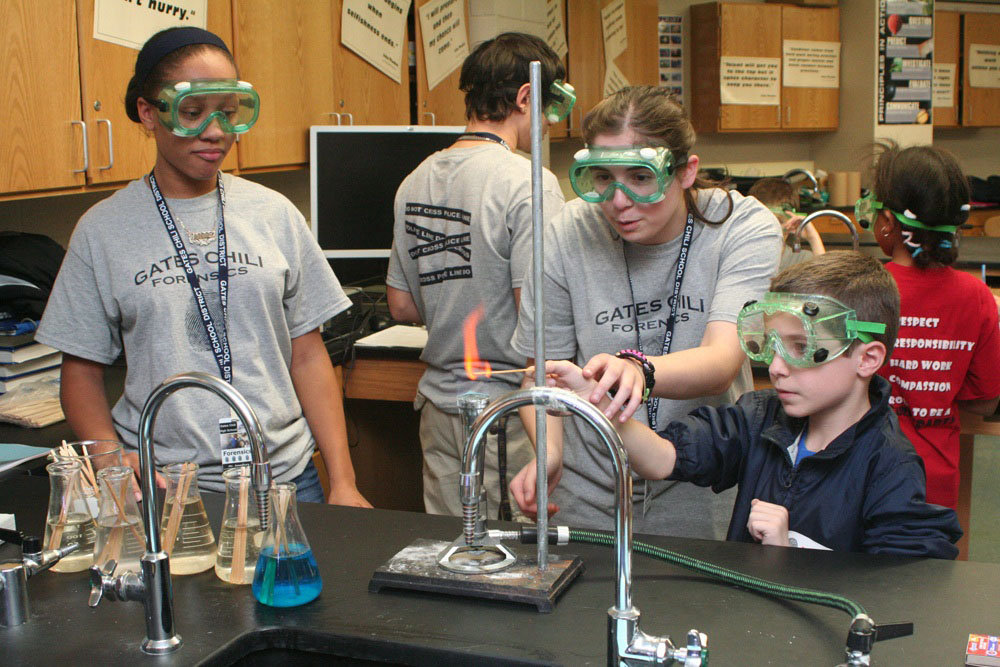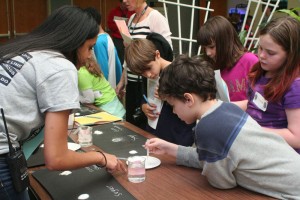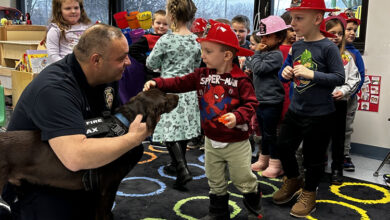Taking science to a different level

High school students are aware NaHCO3 and CH3COOH have a chemical reaction when mixed. Third-graders may look at the molecular formulas and wonder how to pronounce them or why the numerals are tiny.
Chris Amesbury’s forensics class was recently challenged with presenting complex science concepts, like the chemical reaction of baking soda and vinegar, in a way that third-grade students would understand and be interested in. This Project-Based Learning (PBL) activity’s theme revolved around a made-up crime in the high school and the forensics that could be used to solve the case.
“Explore any topic you are interested in, even if we haven’t covered it in class,” said Amesbury to his students, emphasizing the PBL aspect student voice and choice.
Amesbury discussed with the upperclassmen what a third-grader’s learning abilities are and showed videos depicting a third-grade classroom. Amesbury worked with Gates Chili teacher Laura Braid and BOCES 2 STEM Coach Leslie Tanner to coordinate the pieces of the PBL.
The forensics class also had assistance from Rochester Museum and Science Center Head of School and Teacher Programs Deborah Massey. She helped the students understand how to make the stations kid friendly and how to interact with third-graders. Part of a PBL is utilizing experts in a given field to further the students’ discovery.

PBL is intended to engage learners’ minds and involve meaningful inquiry. According to the Buck Institute for Education, there are eight essentials for PBL: significant content; a need to know; a driving question; student voice and choice; 21st-century competencies; in-depth inquiry; critique and revision; and public audience.
“Through this project, the high school students were able to think critically, collaborate and be creative,” said Tanner, touching on key competencies that students need to be successful in the workforce.
On October 30, 51 Florence Brasser third-graders were treated to a case of whodunit. They walked into a fake crime scene in the atrium of the high school and then visited seven stations featuring forensics-based activities. The third-graders were there to help solve the crime using evidence, science and observation and the forensics class students assisted them as the culmination of the PBL.
At one station meant to test a white powder found at the scene, third-graders witnessed reactions between various white powders and liquids. When the baking soda and vinegar reacted during the demonstration and again when testing the mystery substance, one student deduced what the white powder was. He was quick to write his answer: “Baking soda because it swelled up.”
Just the reaction the forensics students were looking for.
PBL throughout BOCES 2
In addition to the activity at Gates Chili, BOCES 2 STEM Coach Leslie Tanner has worked with additional BOCES 2 districts to implement Project Based Learning.
Churchville-Chili Teacher Patti Saucke is leading her students through a year-long activity revolving around solving food shortages and featuring hydroponics. More than 20 Churchville-Chili teachers have received formal training on PBL.
Holley students recently designed and built bridges as part of a PBL. A Department of Transportation representative visited the class as an expert in the field and served as an audience during the students’ final presentation.
At Kendall, students utilized a 3D printer to create original fishing lure designs after researching the science and math of fishing lures. The students hope to present their lures to local fishing charters.
To learn more about PBL, visit the Buck Institute for Education at www.bie.org.
Provided information and photos


